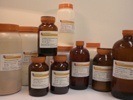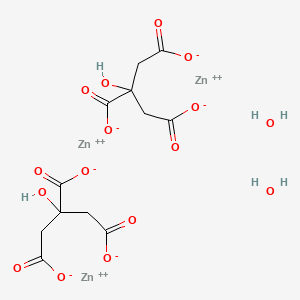SECTION 1. IDENTIFICATION
Product Name: Zinc Citrate Dihydrate
Product Number: All applicable American Elements product codes, e.g. ZN-CAT-02
, ZN-CAT-025
, ZN-CAT-03
, ZN-CAT-035
, ZN-CAT-04
, ZN-CAT-05
CAS #: 5990-32-9
Relevant identified uses of the substance: Scientific research and development
Supplier details:
American Elements
10884 Weyburn Ave.
Los Angeles, CA 90024
Tel: +1 310-208-0551
Fax: +1 310-208-0351
Emergency telephone number:
Domestic, North America: +1 800-424-9300
International: +1 703-527-3887
"
SECTION 2. HAZARDS IDENTIFICATION
CLP Classification - Regulation (EC) No 1272/2008
Health hazards
Based on available data, the classification criteria are not met
Physical hazards
Based on available data, the classification criteria are not met
Environmental hazards
Based on available data, the classification criteria are not met
SECTION 3. COMPOSITION/INFORMATION ON INGREDIENTS
Component / CAS-No / Weight %
Zinc citrate / 5990-32-9 / <=100
SECTION 4. FIRST AID MEASURES
Description of first aid measures
Eye Contact
Rinse immediately with plenty of water, also under the eyelids, for at least 15 minutes. Get medical attention.
Skin Contact
Wash off immediately with plenty of water for at least 15 minutes. Get medical attention immediately if symptoms occur.
Ingestion
Clean mouth with water and drink afterwards plenty of water. Get medical attention if
symptoms occur.
Inhalation
Remove to fresh air. Get medical attention immediately if symptoms occur. Self-Protection of the First Aider No special precautions required.
Most important symptoms and effects, both acute and delayed
None reasonably foreseeable
Notes to Physician
Treat symptomatically.
SECTION 5. FIREFIGHTING MEASURES
Extinguishing media
Suitable Extinguishing Media
Use extinguishing measures that are appropriate to local circumstances and the surrounding environment. Water spray, carbon dioxide (CO2), dry chemical, alcohol-resistant foam.
Extinguishing media which must not be used for safety reasons
No information available.
Special hazards arising from the substance or mixture
Thermal decomposition can lead to release of irritating gases and vapors.
Hazardous Combustion Products
None under normal use conditions.
Advice for firefighters
As in any fire, wear self-contained breathing apparatus pressure-demand, MSHA/NIOSH (approved or equivalent) and full protective gear
SECTION 6. ACCIDENTAL RELEASE MEASURES
Personal precautions, protective equipment and emergency procedures
Ensure adequate ventilation. Use personal protective equipment as required. Avoid dust formation.
Environmental precautions
Should not be released into the environment. See Section 12 for additional Ecological Information.
Methods and material for containment and cleaning up
Sweep up and shovel into suitable containers for disposal. Avoid dust formation.
Reference to other sections
Refer to protective measures listed in Sections 8 and 13
SECTION 7. HANDLING AND STORAGE
Precautions for safe handling
Wear personal protective equipment/face protection. Ensure adequate ventilation. Avoid contact with skin, eyes or clothing. Avoid ingestion and inhalation. Avoid dust formation.
Hygiene Measures
Handle in accordance with good industrial hygiene and safety practice. Keep away from food, drink and animal feeding stuffs. Do not eat, drink or smoke when using this product. Remove and wash contaminated clothing and gloves, including the inside, before re-use. Wash hands before breaks and after work.
Conditions for safe storage, including any incompatibilities
Keep container tightly closed in a dry and well-ventilated place.
Specific end use(s)
Use in laboratories
SECTION 8. EXPOSURE CONTROLS/PERSONAL PROTECTION
Control parameters
Exposure limits
This product, as supplied, does not contain any hazardous materials with occupational exposure limits established by the region specific regulatory bodies
Biological limit values
This product, as supplied, does not contain any hazardous materials with biological limits established by the region specific regulatory bodies
Monitoring methods
BS EN 14042:2003 Title Identifier: Workplace atmospheres. Guide for the application and use of procedures for the assessment of exposure to chemical and biological agents. MDHS14/3 General methods for sampling and gravimetric analysis of respirable and inhalable dust
Derived No Effect Level (DNEL) No information available
Predicted No Effect Concentration (PNEC)
No information available.
Exposure controls
Engineering Measures
None under normal use conditions.
Personal protective equipment
Eye Protection Wear safety glasses with side shields (or goggles) (European standard - EN 166)
Hand Protection Protective gloves
Skin and body protection Long sleeved clothing
Inspect gloves before use. Please observe the instructions regarding permeability and breakthrough time which are provided by the supplier of the gloves. (Refer to manufacturer/supplier for information)
Ensure gloves are suitable for the task: Chemical compatability, Dexterity, Operational conditions, User susceptibility, e.g. sensitisation effects, also take into consideration the specific local conditions under which the product is used, such as the danger
of cuts, abrasion. Remove gloves with care avoiding skin contamination.
Respiratory Protection No protective equipment is needed under normal use conditions.
Large scale/emergency use Use a NIOSH/MSHA or European Standard EN 136 approved respirator if exposure limits
are exceeded or if irritation or other symptoms are experienced
Recommended Filter type: Particle filter 2
Small scale/Laboratory use Maintain adequate ventilation
Environmental exposure controls No information available.
SECTION 9. PHYSICAL AND CHEMICAL PROPERTIES
Physical State Solid
Appearance White
Odor Odorless
Odor Threshold No data available
Melting Point/Range No data available
Softening Point No data available
Boiling Point/Range No information available
Flammability (liquid) Not applicable Solid
Flammability (solid,gas) No information available
Explosion Limits No data available
Flash Point No information available Method - No information available
Autoignition Temperature No data available
Decomposition Temperature No data available
pH No information available
Viscosity Not applicable Solid
Water Solubility No information available
Solubility in other solvents No information available
Partition Coefficient (n-octanol/water)
Vapor Pressure No data available
Density / Specific Gravity No data available
Bulk Density No data available
Vapor Density Not applicable
SECTION 10. STABILITY AND REACTIVITY
Reactivity None known, based on information available
Chemical stability
Stable under normal conditions.
Possibility of hazardous reactions
Hazardous Polymerization No information available. Hazardous Reactions None under normal processing.
Conditions to avoid
Incompatible products. Excess heat.
Incompatible materials
None known.
Hazardous decomposition products
None under normal use conditions
SECTION 11. TOXICOLOGICAL INFORMATION
Product Information
(a) acute toxicity;
Oral No data available
Dermal No data available
Inhalation No data available
(b) skin corrosion/irritation; No data available
(c) serious eye damage/irritation; No data available
(d) respiratory or skin sensitization;
Respiratory No data available
Skin No data available
(e) germ cell mutagenicity; No data available
(f) carcinogenicity; No data available
There are no known carcinogenic chemicals in this product
(g) reproductive toxicity; No data available
(h) STOT-single exposure; No data available
(i) STOT-repeated exposure; No data available
Target Organs No information available. (j) aspiration hazard; Not applicable
Solid
Symptoms / effects,both acute and delayed
No information available.
Information on other hazards
Endocrine Disrupting Properties
Assess endocrine disrupting properties for human health. This product does not contain any
known or suspected endocrine disruptors.
SECTION 12. ECOLOGICAL INFORMATION
Toxicity
Ecotoxicity effects Contains no substances known to be hazardous to the environment or that are not degradable in waste water treatment plants.
Persistence and degradability No information available
Bioaccumulative potential No information available
Mobility in soil No information available
Results of PBT and vPvB assessment
No data available for assessment.
Endocrine disrupting properties
Endocrine Disruptor Information This product does not contain any known or suspected endocrine disruptors
Other adverse effects
Persistent Organic Pollutant This product does not contain any known or suspected substance
Ozone Depletion Potential This product does not contain any known or suspected substance
SECTION 13. DISPOSAL CONSIDERATIONS
Waste treatment methods
Waste from Residues/Unused Products
Chemical waste generators must determine whether a discarded chemical is classified as a
hazardous waste. Consult local, regional, and national hazardous waste regulations to
ensure complete and accurate classification.
Contaminated Packaging
Empty remaining contents. Dispose of in accordance with local regulations. Do not re-use
empty containers.
European Waste Catalogue (EWC) According to the European Waste Catalog, Waste Codes are not product specific, but application specific.
Other Information Waste codes should be assigned by the user based on the application for which the product was used.
SECTION 14. TRANSPORT INFORMATION
MDG/IMO Not regulated
UN number
UN proper shipping name
Transport hazard class(es)
Packing group
ADR Not regulated
UN number
UN proper shipping name
Transport hazard class(es)
Packing group
IATA Not regulated
UN number
UN proper shipping name
Transport hazard class(es)
Packing group
Environmental hazards No hazards identified
Special precautions for user No special precautions required
Maritime transport in bulk according to IMO instruments
Not applicable, packaged goods
SECTION 15. REGULATORY INFORMATION
Regulation (EC) No 649/2012 of the European Parliament and of the Council of 4 July 2012 concerning the export and
import of dangerous chemicals
Not applicable
National Regulations
WGK Classification Water endangering class = 3 (self classification)
UK - Take note of Control of Substances Hazardous to Health Regulations (COSHH) 2002
SECTION 16. OTHER INFORMATION
Safety Data Sheet according to Regulation (EC) No. 1907/2006 (REACH). The above information is believed to be correct but does not purport to be all inclusive and shall be used only as a guide. The information in this document is based on the present state of our knowledge and is applicable to the product with regard to appropriate safety precautions. It does not represent any guarantee of the properties of the product. American Elements shall not be held liable for any damage resulting from handling or from contact with the above product. See reverse side of invoice or packing slip for additional terms and conditions of sale. COPYRIGHT 1997-2022 AMERICAN ELEMENTS. LICENSED GRANTED TO MAKE UNLIMITED PAPER COPIES FOR INTERNAL USE ONLY.
 The zinc atom has a radius of 134 pm and a Van der Waals radius of 210 pm. Zinc was discovered by Indian metallurgists prior to 1000 BC and first recognized as a unique element by Rasaratna Samuccaya in 800. Zinc was first isolated by Andreas Marggraf in 1746. In its elemental form, zinc has a silver-gray appearance. It is brittle at ordinary temperatures but malleable at 100 °C to 150 °C.
The zinc atom has a radius of 134 pm and a Van der Waals radius of 210 pm. Zinc was discovered by Indian metallurgists prior to 1000 BC and first recognized as a unique element by Rasaratna Samuccaya in 800. Zinc was first isolated by Andreas Marggraf in 1746. In its elemental form, zinc has a silver-gray appearance. It is brittle at ordinary temperatures but malleable at 100 °C to 150 °C. It is a fair conductor of electricity, and burns in air at high red producing white clouds of the oxide. Zinc is mined from sulfidic ore deposits. It is the 24th most abundant element in the earth's crust and the fourth most common metal in use (after iron, aluminum, and copper). The name zinc originates from the German word "zin," meaning tin.
It is a fair conductor of electricity, and burns in air at high red producing white clouds of the oxide. Zinc is mined from sulfidic ore deposits. It is the 24th most abundant element in the earth's crust and the fourth most common metal in use (after iron, aluminum, and copper). The name zinc originates from the German word "zin," meaning tin. (also known as metalorganic, organo-inorganic and metallo-organic compounds) sold by American Elements under the trade name
(also known as metalorganic, organo-inorganic and metallo-organic compounds) sold by American Elements under the trade name
